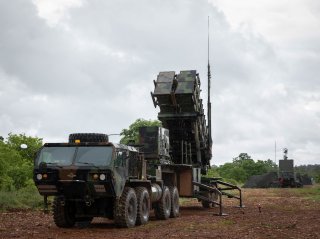Will the Patriot Air Defense System Be a Lifesaver for Ukraine?
The United States is officially sending Ukraine its long-serve Patriot air defense system to help defend the embattled nation’s civilian infrastructure.
Despite the leap in performance, PAC-3 missiles are much smaller than PAC-2 interceptors, reducing their overall range despite the interceptor’s improved aerobatics allowing them to defend a larger overall area. The PAC-3 MSE, or Missile Segment Enhanced, is slightly larger and offers different capabilities than the PAC-3 CRI, which stands for Cost Reduction Initiative.
How much heat can each Patriot battery carry?
A single Patriot battery can include up to eight separate M901 launch stations. A launch station carries up to four launch canisters on a two-axle trailer. These canisters can each hold one PAC-2 GEM-T interceptor, three PAC-3 enhanced missiles, or as many as four PAC-3 CRI (cost reduction initiative) missiles. America’s Patriot systems tend to deploy with an assortment of these interceptors to offer the best option for whatever the incoming threat may be.
What about the Patriot’s radar system?
Patriot batteries have operated a number of different radar systems over the years, known as the AN/MPQ-53, AN/MPQ-65, and AN/MPQ-65A radars. Unlike the Nebo-M system leveraged by Russia’s S-300 and S-400 systems, the Patriot radar actually combines surveillance, tracking, and engagement functions into one assembly mounted on a single trailer — dramatically reducing deployment time and increasing mobility while offering the same function and performance of multiple arrays.
The AN/MPQ-53 system operates at the C-band frequency range for long-range detection (low-frequency) and at the G/H bands for precision targeting at distances claimed to be as great as 100 kilometers (62 miles), while the more modern AN/MPQ-65 systems offer a disclosed range of better than 150 kilometers (or about 93 miles).
However, the older MPQ-53 system has been reported to actually offer a range of up to 170 kilometers (105 miles), suggesting the newer MPQ-65 can actually reach significantly further than had been acknowledged.
The more advanced MPQ-65 system is said to be capable of tracking up to 100 airborne targets simultaneously while guiding nine separate missiles toward their targets.
Despite their high degree of capability, these arrays do have limitations, however. One notable limitation is its inability to offer full 360-degree scanned coverage.
Today, the Army is working on rolling out another, even newer, radar array for the Patriot, dubbed the Lower Tier Air and Missile Defense System (LTAMDS), part of Raytheon’s GhostEye family of radars. It promises offer full 360-degree coverage. Despite being about the same size as previous Patriot radar systems, Raytheon claims it offers twice the power.
Which radar system the Patriot battery provided to Ukraine will operate has not been disclosed thus far.
How effective is the Patriot air defense system?
As is so often the case when discussing advanced military systems, trying to assess the Patriot’s real efficacy is a simple question with a complicated answer. Historically speaking, the Patriot system has seen a dramatic improvement since its rocky start in the Gulf War, achieving what SFC Long says is around a 95% intercept success rate.
But Long himself will tell you that there’s much more to the story when it comes to air defenses than simply comparing intercept ratios between very different systems like America’s Terminal High Altitude Area Defense (THAAD), Israel’s Iron Dome, or Russia’s S-400. Each of these systems was designed for specific (and often different) portions of the air defense enterprise. But further than that, they also see very different rates of use.
“Right now, on paper, THAAD has a 100% engagement efficiency. It has had one engagement and hit one missile,” he explains.
And while the Patriot system currently has around a 95% success rate, it still only engages a few times a year. The more frequently the system is called on to defend against incoming threats, the more chances it has to fail and the lower its overall success rate may be. Iron Dom, Long points out, may have a success rate of just 80-85%, but it sometimes sees use multiple times per week, giving it that many more opportunities to fail.
On paper, the MIM-104 Patriot air defense system is among the most advanced and capable missile defense assets on the face of the planet, and there’s a sound argument to be made that it’s even more advanced and capable than Russia’s much-touted S-400… but the complicated reality of the air defense enterprise is that it’s extremely complex, and nothing is invincible.
This article was first published by Sandboxx News.
Alex Hollings is a writer, dad, and Marine veteran who specializes in foreign policy and defense technology analysis. He holds a master’s degree in Communications from Southern New Hampshire University, as well as a bachelor’s degree in Corporate and Organizational Communications from Framingham State University.
Image: DVIDS.

